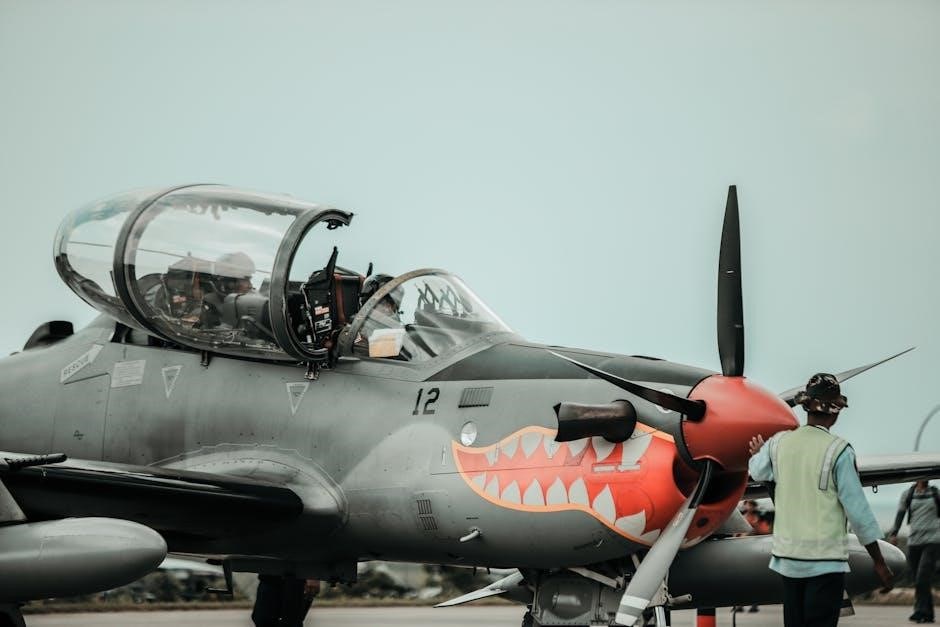Army ground guide signals are essential for safe vehicle maneuvering. They provide a standardized communication method between the ground guide and driver, ensuring the safe movement of military vehicles, especially in challenging environments. Effective signaling is crucial for preventing accidents.
Importance of Ground Guides in Military Operations
Ground guides play a vital role in military operations, serving as the eyes and ears for vehicle operators. Their presence is crucial for maneuvering vehicles safely, especially in congested areas or limited visibility. Ground guides mitigate risks by providing clear hand and arm signals, facilitating effective communication amidst the noise and chaos of a battlefield. They ensure the safe movement of vehicles, preventing accidents and protecting personnel. Their expertise enhances operational efficiency and minimizes potential hazards during tactical movements and logistical operations, making them indispensable for mission success.
Essential Ground Guide Responsibilities
Ground guides are responsible for safe vehicle maneuvering; They act as the driver’s eyes and ears. Effective communication using standardized signals is essential, ensuring safety and preventing accidents during military operations involving vehicle movement.
Ensuring Safe Vehicle Maneuvering
The primary responsibility of a ground guide is ensuring the safe maneuvering of vehicles. This involves providing clear and precise signals to the driver, guiding them through obstacles, confined spaces, and challenging terrains. Ground guides must remain alert and aware of their surroundings, anticipating potential hazards. Effective communication, adherence to standardized signals, and constant vigilance are critical for preventing accidents and ensuring the safe operation of military vehicles in diverse environments. A well-trained ground guide significantly reduces the risk of collisions, rollovers, and other vehicle-related incidents.
Acting as Eyes and Ears for the Driver
Ground guides serve as the driver’s eyes and ears, especially when visibility is limited or the vehicle’s size restricts the driver’s field of vision. They observe the surroundings, identify potential hazards, and communicate critical information to the driver through standardized signals. In noisy environments or complex situations, the ground guide’s visual signals become invaluable. This role requires constant alertness, quick decision-making, and a thorough understanding of the vehicle’s capabilities and limitations. By providing real-time feedback and guidance, ground guides significantly enhance the driver’s awareness and contribute to safer vehicle operations, preventing potential accidents.
Standard Hand and Arm Signals
Hand and arm signals are the primary means of communication between ground guides and drivers. These signals offer a clear and concise way to convey instructions, ensuring safe and effective vehicle maneuvering.
Basic Communication Method
Standard hand and arm signals form the foundation of ground guide operations, providing a visual language for directing vehicle movement. Due to the noise level of vehicles and other equipment, these signals are the primary means of communication. Drivers and ground guides must be proficient in these signals. This proficiency ensures that instructions are clearly understood, promoting safety and efficiency during tactical movements and other vehicle operations. Consistent use of these signals minimizes misunderstandings and potential accidents, making them indispensable.
Night Operations: Flashlight Signals
During night operations, screened flashlights become essential for ground guiding. These flashlights allow for clear communication. They provide visibility without compromising the tactical situation, ensuring safe vehicle maneuvering in low-light conditions;
Using Screened Flashlights for Guidance
Screened flashlights are vital for guiding vehicles during night operations. These flashlights must utilize proper screening to minimize light dispersion and maintain operational security. Ground guides employ specific flashlight signals, mirroring daytime hand signals, to direct the driver. The consistent application of these signals ensures clarity and prevents confusion, especially in limited visibility. Always ensure the flashlight is functioning correctly and the signals are pre-coordinated with the driver before commencing vehicle movement. Effective use minimizes risk.
Coordination and Communication
Effective coordination and communication are vital between the ground guide and driver. Clear understanding of signals and pre-operation briefings ensure safe maneuvering. Consistent communication protocols minimize errors and enhance operational efficiency.
Pre-Operation Signal Coordination
Prior to any vehicle movement, drivers and ground guides must coordinate signals. This ensures a shared understanding of hand and arm signals, especially in limited visibility. Discussing the route, potential hazards, and specific signals reduces miscommunication. Standardized signals and clear communication before operations are paramount for safety and efficiency. This includes confirming understanding of stop signals and adapting signals for specific environmental conditions. Proper pre-operation coordination drastically minimizes the risk of accidents during vehicle maneuvering.
Understanding Between Ground Guide and Driver
Effective ground guiding relies on a mutual understanding between the ground guide and the driver. Both must be proficient in standard hand and arm signals. The driver needs to trust the guide’s directions, and the guide must clearly convey instructions. This understanding is developed through training and pre-operation briefings. Any ambiguity in signals can lead to dangerous situations; therefore, clarity is essential. Factors like noise levels, visibility, and terrain demand even greater comprehension. Consistent practice reinforces trust and communication between the guide and driver, improving safety.
Teamwork and Standardization
Teamwork and standardization are critical in ground guiding. Consistent signal usage ensures effective communication. Familiarity with signals fosters teamwork, minimizing errors and maximizing safety during vehicle maneuvers in various operational environments;
Importance of Consistent Signal Usage
Consistent signal usage is paramount for successful ground guiding operations. When every member of the team understands and uses the same signals, communication becomes seamless and efficient. This standardization minimizes misunderstandings, which can be especially critical when maneuvering heavy tactical vehicles. Consistent signals reduce the risk of accidents, promote safe vehicle operations, and ensure that the driver and ground guide work together effectively. Proper execution relies on shared knowledge and consistent practices, ultimately enhancing mission success and personnel safety.
Familiarity with Signals for Effective Teamwork
Familiarity with ground guide signals is essential for fostering effective teamwork. When team members are well-versed in these signals, they can communicate quickly and accurately, enhancing coordination during vehicle maneuvers. This shared understanding is crucial for preventing misunderstandings and promoting safety. Teamwork thrives on clear, unambiguous communication, and a thorough knowledge of ground guide signals ensures that everyone is on the same page. This familiarity builds confidence, reduces errors, and ultimately contributes to successful mission outcomes, ensuring a cohesive and efficient team performance.

Safety Protocols
Safety protocols for ground guiding prioritize the well-being of all personnel. Strict adherence to hand signals and immediate cessation of movement when uncertain are paramount. A culture of safety is key.
When in Doubt, Stop
In ground guiding, uncertainty demands immediate cessation of vehicle movement. If the ground guide is unsure of the path ahead, encounters an unforeseen obstacle, or loses clear communication with the driver, the primary directive is to halt the vehicle. This protocol prevents potential accidents, property damage, and injuries. Prioritizing caution ensures the safety of personnel and equipment. Remember, when visibility is compromised or signals are unclear, stop and reassess before proceeding further, underscoring that safety trumps expediency in all ground guiding operations.
Prioritizing Safety Above All Else
Safety must be the foremost consideration in all ground guide operations. The ground guide’s primary responsibility is to ensure the safe maneuvering of vehicles, even above mission objectives. This involves maintaining constant situational awareness, anticipating potential hazards, and employing clear, concise communication through standardized signals. Drivers and ground guides must remain alert and prepared to react to changing conditions. Strict adherence to safety protocols, including pre-operation briefings and equipment checks, minimizes risks. A commitment to safety protects personnel, prevents damage to equipment, and ultimately contributes to mission success. When moving vehicles, never compromise safety.

Using Two Ground Guides
Employing two ground guides enhances safety and situational awareness. With one guide positioned at the front and another at the rear, comprehensive coverage of the vehicle’s surroundings is achieved, minimizing blind spots.
Positioning and Roles of Front and Rear Guides
When utilizing two ground guides, the front guide is positioned on the left front, while the rear guide is on the left rear. The front guide assumes primary responsibility for directing the driver, providing instructions for maneuvering forward. The rear guide monitors the vehicle’s rear, ensuring clearance and preventing collisions. This dual setup enhances safety and awareness. The guides must maintain visual contact to facilitate coordinated movements.
Signal Hierarchy: Left Front Guide Signals Driver
In a two-ground guide system, a clear signal hierarchy is crucial. The left front guide holds the primary responsibility for signaling the driver. The rear guide communicates with the front guide. The driver responds only to the signals from the front guide. This ensures a single point of control, reducing confusion. If the front guide loses sight of the rear guide’s signal, they must immediately signal the driver to stop, prioritizing safety above all else.
Signals in Specific Scenarios
Specific scenarios, like night parking, require tailored signals. Clear communication is vital when establishing contact with guards. Ground guides must adapt signals to environment and conditions for safe operation.
Night Parking Area Procedures
When a vehicle arrives at a night parking area, excluding tactical assembly areas, a ground guide dismounts to contact the guard on duty. This procedure is crucial for security and coordination. The ground guide uses specific flashlight signals to direct the vehicle, ensuring it parks safely and efficiently. Clear communication with the driver is paramount, utilizing pre-coordinated signals to avoid confusion. Establishing contact with the guard ensures proper authorization and prevents unauthorized access, enhancing overall security protocols in low-visibility conditions.

Visual Signals
Visual signals include hand-and-arm signals, which are a fundamental communication method. Prior to movement, a 360-degree walk-around inspection should be conducted. These signals are essential for ground guides to effectively communicate with vehicle operators.
360-Degree Walk-Around Inspection
Before initiating any ground guiding operation, conducting a comprehensive 360-degree walk-around inspection of the vehicle and surrounding area is crucial. This inspection helps identify potential hazards, obstacles, or personnel in the immediate vicinity. This proactive measure ensures the safety of both the vehicle operators and ground personnel. Identifying such hazards before movement can prevent accidents, injuries, or damage to equipment. The inspection should also confirm that all signals are coordinated between drivers and ground guides.

Other Types of Visual Signals
Beyond standard hand and arm signals, the army utilizes pyrotechnic and ground-to-air signals. These alternative methods are employed when greater distances or specific operational needs dictate their use for effective communication.
Pyrotechnic Signals
Pyrotechnic signals serve as visual communication tools, especially useful over extended distances or in situations where hand signals are insufficient. Typically issued as complete rounds, these signals include hand-held devices and ground smoke, offering distinct methods for conveying messages. Their use demands careful consideration and adherence to safety protocols due to their inherent nature. Soldiers must be trained in the proper identification and interpretation to communicate effectively on the battlefield or during training exercises, ensuring clear and concise communication.
Ground-to-Air Signals
Ground-to-air signals are critical for communicating with aircraft, often employed in situations where radio communication is unavailable or unreliable. These signals can include various methods, such as using panels, mirrors, or specific body postures, to convey essential information like location, distress, or mission-related data. Effective use requires thorough training and a clear understanding of standardized procedures. Soldiers must be proficient in both creating and interpreting these signals to facilitate coordination between ground forces and air assets, enhancing overall operational effectiveness and safety.